WHY CITY NEPHI COULD NOT HAVE BEEN KAMINALJUYU, GUATEMALA
Why City Nephi Could Not Have Been Kaminaljuyu, Guatemala
There are many reasons why I believe that the Pre-classic site of Kaminaljuyú, near downtown Guatemala City, could not have been the location of the land and city of Nephi of the Book of Mormon as proposed by the Allens at page 571 of their book, Exploring the Lands of the Book of Mormon, 2010 2nd edition, (hereafter designated as Exploring). Dr. Richard Hauck has done, and is still doing, extensive work in defining all the requirements outlined in the Book of Mormon for locating the land of Nephi. He is currently writing about those requirements and about which of the requirements have been identified archeologically and geographically.
In this article I will discuss four of those requirements, not to prove where the land of Nephi was located, but mainly to show why the land and city of Nephi could not have been located at Kaminaljuyú;
1. Shilom and Nephi must have been within eyesight of the narrow strip of wilderness.
2. There must have been a substantial and visible hill north of Shilom.
3. Too many “potentially hostile Maya” were living at Kaminaljuyú when Nephi Landed.
4. Kaminaljuyú was located too far from the waters of Mormon if the waters of Mormon were located at or near Lake Atitlan.
The cities of Nephi and Shilom must have been within eyesight of the narrow strip of mountainous wilderness & of the hill north of Shilom.
(A) Mosiah 1 used the hill north of Shilom as a gathering place about 200 BC
Nephi landed west of the narrow strip of mountainous wilderness on the Pacific coast about 588 BC. After 2 or 3 years, when Joseph was still “little” (2 Nephi 3:25), Nephi moved with “all those who would go with [him]… into the wilderness.” This included 3 couples and their children plus Jacob, Joseph, and Nephi’s sisters and perhaps their children. I submit that this small colony did not exceed 25 to 30 people, unless they had converted a few local people, possibly Jaredite colonists. After “many days” they settled in a land they called Nephi, located south of the narrow strip of mountainous wilderness that extended from the east sea to the west sea.
About 380 years later King Mosiah 1 (about 200 BC) obeyed the Lord and fled from Nephi to Zarahemla which was located north of the narrow strip of mountainous wilderness:
Omni 1:13. “…He did according as the Lord had commanded him. And they departed out of the land into the wilderness, as many as would hearken unto the voice of the Lord; [Mosiah11:13] [up to] the hill north of the land of Shilom, which had been a place of resort for the children of Nephi at the time they fled out of the land… [Omni 1:13 continuing]…through the wilderness until they came down into the land which is called the land of Zarahemla.”
The hill north of Shilom was a gathering place for Mosiah 1 to assemble “all those who would hearken unto the voice of the Lord.” How many were there? I suspect something between 5 and 20 thousand. For purposes of this article the important point is that, according to these scriptures, the hill north of Shilom was located at the very southern edge of the narrow strip of mountainous wilderness. It was very close, within eyesight, and probably within a couple of miles, of the city of Shilom. And further, it must have been an area large enough, and with sufficient water, where several thousand people could have gathered and lived (a place of resort for those fleeing from Nephi, Shilom, and surrounding area) at least for a few days before traveling through the wilderness and then down to Zarahemla.
(B) King Noah built a tower on the Hill north of Shilom.
King Mosiah I died in Zarahemla and his son King Benjamin reigned in his stead. Sometime during his reign, about the year 170 BC or so, an overzealous man named Zeniff returned to the land of Nephi with “a considerable number” of all those who “were desirous to go up to possess the land of Nephi” from which they had fled about 20 to 30 years prior. Mosiah 9:6-8 states:
[The cunning King of the Lamanites] covenanted with me that I might possess the land of Lehi-Nephi, and the land of Shilom. He also commanded that his people should depart out of the land, and I and my people went into the land…and we began to build buildings and to repair the walls of the city, yea, even the walls of the city of Lehi-Nephi, and the city of Shilom.
About 35 years later (ca.135 BC), Zeniff conferred his kingdom upon his son Noah. Noah was a very vain and wicked Nephite king. At Mosiah 11:1-13 it says, quoting the pertinent parts:
“…King Noah built many elegant and spacious buildings…he also built him a spacious palace and a throne in the midst thereof…and the seats which were set apart for the high priests, which were above all the other seats, he did ornament with pure gold; and he caused a breastwork to be built before them, that they might rest their bodies and their arms upon while they should speak lying and vain words to his people….and…he built a tower near the temple; yea, he could stand upon the top thereof and overlook the land of Shilom and also the land of Shemlon, (all these areas must have been within a couple of miles of each other, including the hill north of Shilom because they were visible from Nephi) which was possessed by the Lamanites and he could even look over all the land round about…and he caused a great tower to be built on the hill north of the land of Shilom.…”
Why the very vain, proud, and wicked King Noah built a second tower and why he built it upon the hill north of Shilom is not explained. It could have been for defensive purposes or, more likely, it could also have been a monument for himself. Obviously the great tower king Noah built on the hill north of Shilom was obvious to the people. I submit that it was within eyesight of the people living in the land of Shilom. The city of Nephi was located just southward from Shilom. I submit that this hill north of Shilom could not have been more than 2 or3 miles from Shilom.
(C) Ammon and his 15 scouts used the hill north of Shilom
as their base to observe Shilom and Nephi.
From about 135 BC to 121 BC there were many skirmishes between the Lamanites and King Noah’s Nephites. King Noah was finally killed and his righteous son Limhi became King. The Lamanites imposed a 50 percent tax on Limhi and his people and had “surrounded them on every side.” They prayed for deliverance. Ammon and 15 others were sent by Mosiah II, about 121 BC, to inquire about Zeniff and his followers. Mosiah 7:3-15 states:
4. …They knew not the course they should travel in the wilderness to go up to the land of Lehi-Nephi; therefore they wandered many days in the wilderness.…
5. And when they had wandered forty days (in the narrow strip of mountainous wilderness) they came to a hill, which is north of the land of Shilom, and there they pitched their tents.
6. And Ammon took three of his brethren…and they went down into the land of Nephi.
7. …King Limhi commanded his guards…that they should go to the hill which was north of Shilom, and bring their brethren into the city, that thereby they might eat, and drink, and rest themselves from the labors of their journey…(the hill was very close to Shilom).
They located first on the hill north of Shilom where Ammon reconnoitered Shilom and Nephi and then he took 3 of his men and went down to meet Limhi.
Clearly the hill north of Shilom was very close to Shilom and not more that 2 or 3 miles because people could see Noah’s tower there. Ammon could see Shilom from the hill. It was a place close enough for Mosiah 1 to gather his people fleeing from the land of Nephi before going through the narrow strip of wilderness to go down to Zarahemla. This was a prominent hill and one that was located at the very southern edge of the narrow strip of mountainous wilderness. Remember Nephi was not “in” the Narrow strip of wilderness but south of it. It also must have been a large enough hill adjacent to and part of the narrow strip of wilderness that several thousand people could have occupied it during the time of gathering of the people of Mosiah 1 before crossing the narrow strip of wilderness on their way to Zarahemla.
I submit that there is no qualifying hill anywhere near the Kaminaljuyú complex in Guatemala City. This 6-kilometer-square complex was built about 1000 BC upon a high plateau (elevation about 5000 ft) and above the many deep ravines in the area. There is no qualifying hill to the north of, and above, Kaminaljuyú and the surrounding area, until one comes to the Chuacus Mountains some 30 air miles on the north. In order to get to the narrow strip of wilderness from Guatemala city, one must descend from an elevation of over 5000 feet to the Motagua River (elevation about 2000 feet) and then ascend over the Chuacus mountains, (elevation about 6000 feet) and then cross the Salamá valley to finally get to the Sierra de las Minas Mountains (narrow strip of wilderness) about 50 air miles northward from Kaminaljuyú.

The Chuchumatanes/Sierra de Las Minas chain of mountains is believed by Garth Norman, Richard Hauck, and the Allens to be the narrow strip of mountainous wilderness. One cannot see this range of mountains from Guatemala City (Kaminaljuyu) (See maps below)
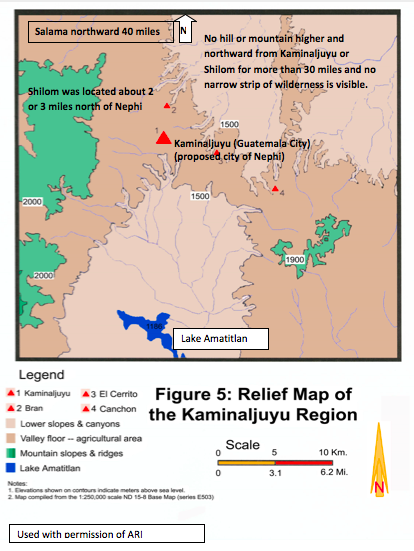
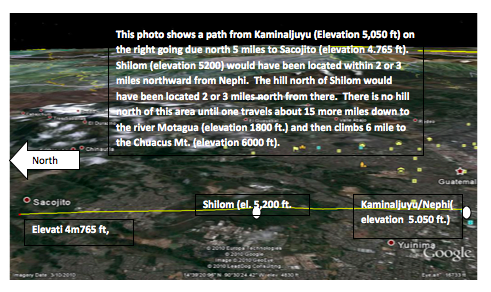
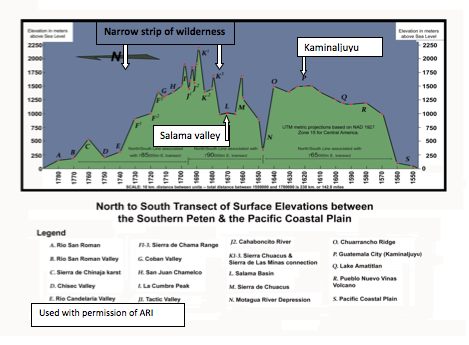
One cannot see the narrow strip of mountainous wilderness from Kaminaljuyú. Travel today in a car over paved roads from Kaminaljuyú to the southern edge of the narrow strip of wilderness takes 3 hours to give an idea how rugged and difficult travel in that region is and was. If one takes the dirt road that more closely follows the ancient trade route it takes at least 8 hours.
Therefore, I believe that it must be concluded that Kaminaljuyú cannot be the city of Nephi because it is too far away, and there is no significant hill that could qualify as the hill north of Shilom from which Ammon could have seen the cities of Nephi and Shilom.
Too many “potentially hostile Maya” lived in Kaminaljuyú in 588 BC.
When Lehi landed on the western end of the narrow strip of wilderness (the Pacific coast) in 588 BC, Kaminaljuyú was a huge “city/state” with more than 40,000 people living in the area. It was a beautiful city surrounding a lake with a dam and irrigation canals providing water for a large agricultural area (see picture below). This Mayan culture enjoyed extensive trading with other “city states” along the west coast through Izapa. This trade route continued through the Isthmus of Tehuantepec facilitating trade with areas like Oaxaca, La Venta, Tres Zapotes, and many others. The Maya people living in the area of Kaminaljuyú also sought captives to practice blood sacrifice as they expanded their territory (Wikipedia).
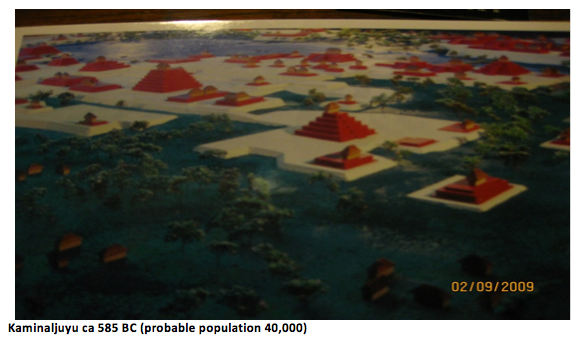
When Lehi landed in 588 BC the Jaredites were probably close to their height wherein many hundreds of thousands of people lived northward from the Nephites’ landing place. Between Kaminaljuyú and the Tehuantepec area, where the Jaredites lived, there were many thousands more people (probably Jaredite colonists) occupying large cities like: El Baul, Monte Alto, La Democracia (near Escuintla, Guatemala) and from there northward along the Pacific coast to cities like Abak Takalik, Ocos, Izapa, Pijijiapan,and Tuztzuculi (which was located near the pacific side of the Tehuantepec Isthmus). The following map shows the approximate trade route that existed about that time.
I submit that Nephi would quickly have become aware of these population centers and, being required of the Lord to preserve his Hebrew religion and Christian beliefs, would not have taken his 3 or 4 adult males, 5 or 6 adult females and 15 plus young children to such an area as Kaminaljuyú or northward to the Jaredite nation. There is no way he could have conquered, converted, or assimilated them into his system of beliefs and practices. There is also no archaeological evidence to suggest that there were two different cultures co-existing at Kaminaljuyú from about 500 BC to ca. AD 200.
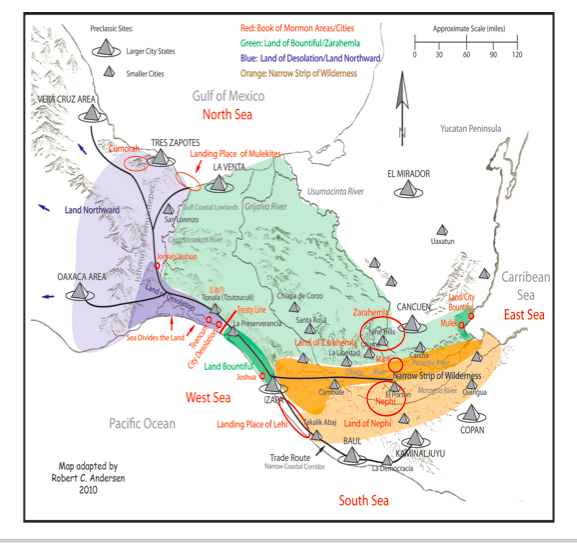
Therefore, I believe there were just too many “potentially hostile Maya” people living in the Kaminaljuyú area at the time the Nephites landed west of the narrow strip of wilderness for it to have been the land of Nephi.
If “Waters of Mormon” was Lake Atitlan then Kaminaljuyú could not have been the city of Nephi because the distance was too great.
I submit that if the “waters of Mormon” were located at Lake Atitlán as proposed in Exploring at pages 478,484,636-639, then Kaminaljuyú could not have been the city of Nephi because it was too far, according to the Book of Mormon, for the followers of Alma to have had weekly meetings there. At page 639, Exploring, it states:
If Lake Atitlan is the waters of Mormon and if the city of Lehi-Nephi…is in the area of Guatemala City, then approximately 10 days of travel time were required for Alma and his converts to travel to the land of Mormon. (The wording here implies that they traveled 10 days and lived at the waters of Mormon. This concept does not seem possible considering the following scriptures).
The pertinent Book of Mormon scriptures that show the correct distance between “waters of Mormon” and the cities of Nephi and Shilom to be less than a half day’s journey are as follows: As one reads the following, ask how could all of these events have taken place 10 days away from the place where the followers of Alma were living at the cities of Nephi and Shilom?
Alma 18:1….Alma, who had fled from the servants of King Noah…went about privately among the people [the people had not fled yet] and began to teach the words of Abinadi [Alma was still living in the area and not 10 days journey away].
3…he taught them privately, that it might not come to the knowledge of the king [he initially taught them in their homes or at least not in public places].
4…as many as did believe him did go forth to a place, which was called Mormon, having received its name from the king [It does not say that the believers moved their families and belongings anywhere. First he taught them in the homes, probably at night, and then those that believed him started meeting where he was “resorting” at the waters of Mormon in the thicket of small trees].…
5…there was in Mormon, a fountain of pure water, and Alma resorted [lived] thither, there being near the water a thicket [not the wilderness] of small trees, where he did hide himself in the daytime from the searches of the king [there were daily searches. Apparently he began teaching the people in their homes or in private places, and perhaps at night, else why did he hide during the daytime?].
6. as many as believed him went thither to hear his words. [After he converted a few then they began to meet at the waters of Mormon. They went back and forth from their abodes in Nephi and Shilom to the waters of Mormon. Therefore, the distance from Nephi to the “waters of Mormon” could not have been more than the time it took to travel from Nephi to the waters of Mormon, have a meeting and teaching experience, and then return home to Nephi all within one day. I submit that this distance would not have been over 4 or 5 miles].
7….after many days there were a goodly number gathered together at the place of Mormon [it says “gathered” not “living”. I submit that had this many people been living at the waters of Mormon, King Noah would have discovered the movement much sooner].
16…after this manner he did baptize everyone that went forth [implies not a great distance and that they were not living at the waters of Mormon but in Nephi and Shilom] to the place of Mormon; and they were in number about 254 souls.…
17…they were called …the church of Christ from that time forward…whosoever was baptized…was added to his church.[again this implies frequent additions to the church and frequent visits to waters of Mormon which would not have been possible if it were located 10 days away].
24…he also commanded them that the priests whom he had ordained would labor with their own hands for their support. [They were not laboring at the waters of Mormon where Alma was hiding but in their own homes and lands in Nephi and Shilom.]
25…there was one day in every week that was set apart that they should gather themselves together [at the waters of Mormon] to teach the people, and to worship…and as often as it was in their power, to assemble themselves together. [If Mormon was 10 days away from Nephi and if they had moved to the waters of Mormon with their families and living there then they would have had the power to meet any time they desired without fear. I submit that the army of King Noah did not make daily searches of the “waters of Mormon” at Lake Atitlán, 10 days distance away from Nephi, nor was the army of King Noah living in the area of the waters of Mormon].
30…all this was done in Mormon, yea, by the waters of Mormon, in the forest (thicket of small trees) that was near the waters of Mormon, …[this certainly means all the meetings, teachings, and baptizing was done at the waters of Mormon, except for the initial teaching Alma did in their homes or private places].
31…these things were done in the borders of the land, that they might not come to the knowledge of the king. [I submit that 10 days away is not in the borders of the land. The borders of the land would have been the borders of the land of Nephi and Shilom because all other lands surrounding them were occupied and controlled by the Lamanites.]
32…the king, having discovered a movement among the people, sent his servants to watch them [they were clearly still living in Nephi and Shilom and not at Mormon]. Therefore on the day that they were assembling themselves together to hear the word of the Lord they were discovered unto the king. [How could the servants of Noah watch them assemble and on that same day advise King Noah who then sent his army to destroy them if they were assembling at Lake Atitlán 20 days round trip away?]
33…the king said that Alma was stirring up the people to rebellion against him; therefore he sent his army to destroy them. [How could the people rebel if they lived 20 days round trip from where King Noah resided? I submit that this army was not 10 days away from Nephi (20 days round trip) as that would have left King Noah too vulnerable to the Lamanites].
34…Alma and the people of the Lord were apprised of the coming of the king’s army; therefore they took their tents and their families and departed into the wilderness. [I submit that this means the narrow strip of wilderness. They must have known that the King was after them and they had been preparing to flee from the lands of Nephi and Shilom and from the waters of Mormon when the appropriate time came].
35…they were in number about 450 souls.
I do not see how anyone can read the above and believe that the waters of Mormon were 10 days travel, one way, from Nephi. The people were clearly living in their homes in Nephi and Shilom and went back and forth to Mormon in the borders of the land the Lamanites had given them. Therefore, I submit that Mormon could not have been more than a half-day’s walk from Shilom. Shilom was closer to the narrow strip of wilderness than Nephi and the waters of Mormon were closer to the narrow strip of wilderness than Shilom because when they were discovered by King Noah, the people “departed into the wilderness.”
I agree with and appreciate Dr. Stephen L Carr’s comment to me in an E-mail dated 1-11-11:
One point that no one seems to have ever brought up that I've considered, is that the Lamanites allowed Zeniff and his group to settle in only the cities of Nephi and Shilom and the associated nearby farm lands. If Kaminaljuyú is the city/land of Nephi, then Lake Atitlán (10 days' travel away) is way out of the range of territory that the Lamanites would have included as part of the local lands that they had given to the Nephites. This lake would have been solidly in Lamanite territory, and Alma would not have been able to take his followers there for any time at all.
I believe all of the above proves that if the waters of Mormon were located at Lake Atitlán then Kaminaljuyú could not have been city of Nephi because it was too far away. Dr. Hauck and I do not believe that the waters of Mormon were located at Lake Atitlán. The point here is that at least one of the two locations must be incorrect. I personally believe that probably both locations do not conform to the requirements of the Book of Mormon.
If not at Kaminaljuyú then where was the land of Nephi?
If Kaminaljuyú was not the city of Nephi and if the pass through the middle of the narrow strip of mountainous wilderness (Cobán) (as believed by Dr. Richard Hauck and Garth Norman) was the Manti area, then I submit there is only one probable location for the land of Nephi and that is the beautiful Salamá Valley area. There have been over 40 Pre-classic sites located in this general area by the archeological team of David Sedat and Robert Sharer of the University of Pennsylvania cited at University of California Archaeological Research Facility Contribution 16: 23-35, (1972). Within this past year Hauck has discovered at least 5 additional Pre-classic sites in the Salamá valley area that have never been documented.
Hauck has found about 25 of 30 requirements, or so, for locating the land of Nephi in the Salamá Valley area, as required by the Book of Mormon. He is currently excavating in this area and writing about his research and study to see if it can be corroborated as the land of Nephi. There is no doubt that this area contained many thousands of people living in many cities and villages spread over the entire Salamá valley area, and they lived and flourished during the Book of Mormon time period.
It is our belief that when Nephi was prompted by the Lord to move inland, he moved to this very secluded, protected and one the most beautiful valleys in all Guatemala. It is also one that is most productive and has a very agreeable Mediterranean type climate wherein all manner of fruits, vegetables, and grains can be produced Gold, silver, and other minerals, including jade, are also found in the area. Salamá is located just south of the center of the narrow strip of mountainous wilderness that extends from the east sea to the west sea. Over many centuries this area became pivotal to trade through the center of the country. To Dr. Hauck and me it is the most probable location for the land of Nephi and much more probable than the area of Kaminaljuyú.
In summary, I believe that Kaminaljuyú could not have been the city/land of Nephi because:
1. It was just too far from the narrow strip of mountainous wilderness which was not visible from Kaminaljuyú.
2. It had no visible qualifying “hill north of Shilom” as required by the Book of Mormon.
3. There were too many “potentially hostile” people living there (40,000) for Nephi to have been able to have assimilated or conquered.
4. It was too far (10 days travel one way) to Lake Atitlán (believed by many to be the waters of Mormon).
5. Lake Atitlán, 10 days from Kaminaljuyú, would have been in Lamanite control and never would have been given to Zeniff in the first place.


